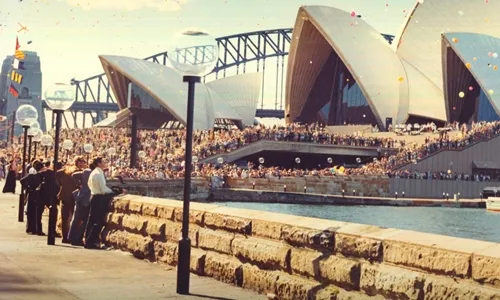
An upcoming exhibition titled "The People's House: Sydney Opera House at 50" has recently been announced. It will be hosted by the Museum of Sydney starting from 1st July and will commemorate the remarkable five-decade history of performances and unforgettable moments that have taken place at Sydney's iconic civic space.
The Sydney Opera House was officially inaugurated on 20th October 1973, following a challenging 14-year construction period that tested the patience of architect Jørn Utzon, the technological capabilities of the time, and the political determination of the NSW government. However, upon its completion, it propelled Sydney onto the global stage. Throughout the construction years, the workers, estimated to be around 10,000 during the building phase, had the privilege of enjoying the initial performances. Renowned international artists such as American singer Paul Robeson and Trinidadian pianist Winifred Atwell graced the concrete foundations with their talent in the 1960s.
As the building neared its final stages, the Opera House invited the site workers and their families to attend a series of concerts to test the acoustics of the Concert Hall. The first complete operas, including the Australian one-act works "The Fall of the House of Usher" by Larry Sitsky and "Dalgerie" by James Penberthy, starring Wulli Wulli tenor Harold Blair, were staged for the public.
During this time, the Australian Ballet hosted the world premiere of its film production of "Don Quixote," and guided tours of the building commenced. The official opening of the Sydney Opera House took place in late 1973. The eagerly anticipated Gala Opening, spanning three nights from 28th to 30th September, marked the beginning of a series of events. The Australian Opera, Sydney Symphony Orchestra, and the Old Tote Theatre Company were among the first to grace the stage.
The festivities continued with the opening festival, which began on 17th October and lasted until the end of the year. It featured concerts, plays, dance performances, exhibitions, and cultural showcases. On 20th October, Queen Elizabeth II officially declared the Sydney Opera House open. In its first year, the professional opera, ballet, music, and theatre companies settled into the Opera House for their opening seasons. They commissioned new productions created by Australian artists, encompassing writing, composition, and choreography. An ongoing Indigenous presence was established, with First Nations performers participating in dance, music, and theatre productions.
Audiences were treated to shows from international companies, and both foreign and local entertainers became headline acts. Promoters and private hirers also booked the various halls for concerts and functions. Notable productions included Prokofiev's epic opera "War and Peace," Mozart's "The Magic Flute," and Shakespeare's "Richard II." The Australian Ballet commenced with "Cinderella," while the ABC Sydney Symphony Orchestra and musical ensembles from Moscow and Cleveland performed in the Concert Hall.
The premiere of new Australian works featured the Old Tote's production of David Williamson's "What If You Died Tomorrow?" Additionally, Aboriginal dancers, including David Gulpilil, choreographed and performed in Michael Boddy's "Cradle of Hercules," which also starred Jack Charles.
Headline acts included The Bee Gees, Kamahl, Petula Clark, and Carol Burnett, whose show was recorded and broadcast across the United States. The Concert Hall stage even hosted an ice rink, as well as hair styling contests and fashion parades.
In 2007, the Sydney Opera House was inscribed on the UNESCO World Heritage List, becoming the youngest cultural site to receive such recognition.
"The People's House: Sydney Opera House at 50" exhibition will bring together a remarkable collection



